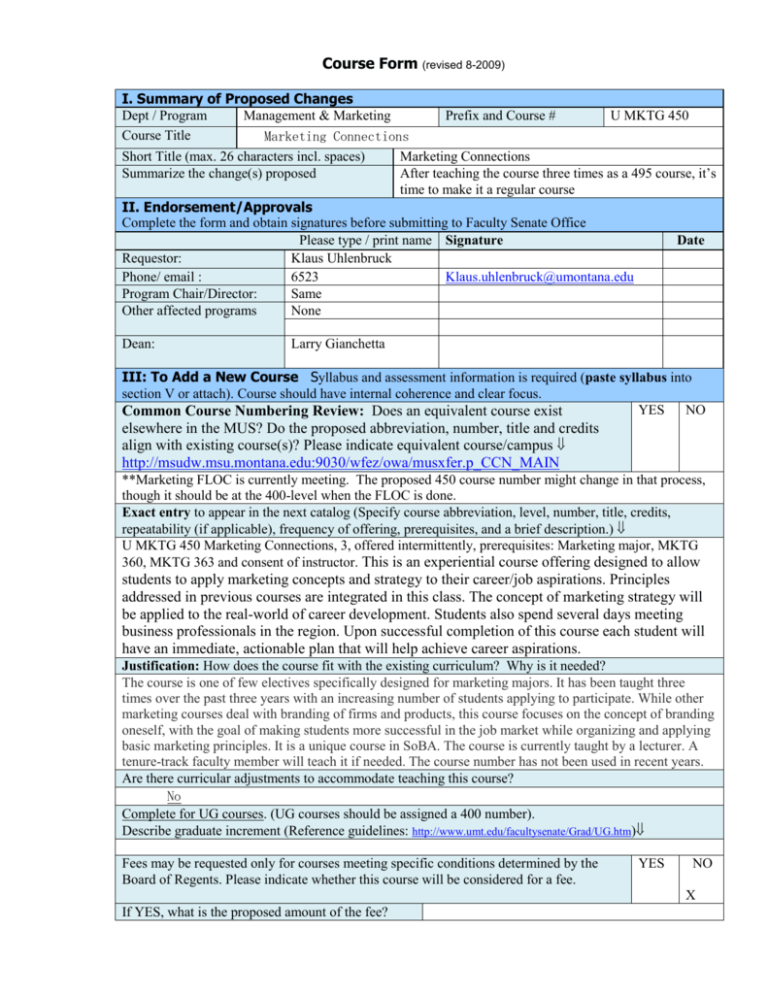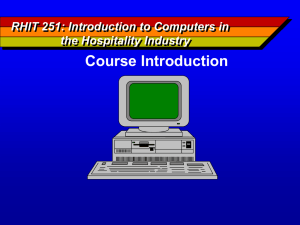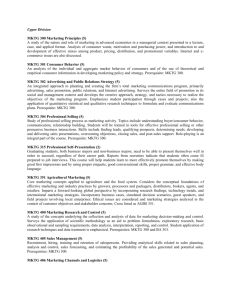
Course Form (revised 8-2009)
I. Summary of Proposed Changes
Dept / Program
Management & Marketing
Course Title
Marketing Connections
Short Title (max. 26 characters incl. spaces)
Summarize the change(s) proposed
Prefix and Course #
U MKTG 450
Marketing Connections
After teaching the course three times as a 495 course, it’s
time to make it a regular course
II. Endorsement/Approvals
Complete the form and obtain signatures before submitting to Faculty Senate Office
Please type / print name Signature
Requestor:
Klaus Uhlenbruck
Phone/ email :
6523
Klaus.uhlenbruck@umontana.edu
Program Chair/Director:
Same
Other affected programs
None
Dean:
Date
Larry Gianchetta
III: To Add a New Course Syllabus and assessment information is required (paste syllabus into
section V or attach). Course should have internal coherence and clear focus.
YES
NO
Common Course Numbering Review: Does an equivalent course exist
elsewhere in the MUS? Do the proposed abbreviation, number, title and credits
align with existing course(s)? Please indicate equivalent course/campus
http://msudw.msu.montana.edu:9030/wfez/owa/musxfer.p_CCN_MAIN
**Marketing FLOC is currently meeting. The proposed 450 course number might change in that process,
though it should be at the 400-level when the FLOC is done.
Exact entry to appear in the next catalog (Specify course abbreviation, level, number, title, credits,
repeatability (if applicable), frequency of offering, prerequisites, and a brief description.)
U MKTG 450 Marketing Connections, 3, offered intermittently, prerequisites: Marketing major, MKTG
360, MKTG 363 and consent of instructor. This is an experiential course offering designed to allow
students to apply marketing concepts and strategy to their career/job aspirations. Principles
addressed in previous courses are integrated in this class. The concept of marketing strategy will
be applied to the real-world of career development. Students also spend several days meeting
business professionals in the region. Upon successful completion of this course each student will
have an immediate, actionable plan that will help achieve career aspirations.
Justification: How does the course fit with the existing curriculum? Why is it needed?
The course is one of few electives specifically designed for marketing majors. It has been taught three
times over the past three years with an increasing number of students applying to participate. While other
marketing courses deal with branding of firms and products, this course focuses on the concept of branding
oneself, with the goal of making students more successful in the job market while organizing and applying
basic marketing principles. It is a unique course in SoBA. The course is currently taught by a lecturer. A
tenure-track faculty member will teach it if needed. The course number has not been used in recent years.
Are there curricular adjustments to accommodate teaching this course?
No
Complete for UG courses. (UG courses should be assigned a 400 number).
Describe graduate increment (Reference guidelines: http://www.umt.edu/facultysenate/Grad/UG.htm)
Fees may be requested only for courses meeting specific conditions determined by the
Board of Regents. Please indicate whether this course will be considered for a fee.
YES
NO
X
If YES, what is the proposed amount of the fee?
**Comment: Students cover personal travel cost.
IV. To Delete or Change an Existing Course – check X all that apply
Deletion
Title
Course Number Change
From:
Level U, UG, G
To:
Description Change
Change in Credits
From:
To:
Prerequisites
1. Current course information at it appears in catalog
(http://www.umt.edu/catalog)
From:
To:
Repeatability
Cross Listing
(primary program
initiates form)
Is there a fee associated with the course?
2. Full and exact entry (as proposed)
3. If cross-listed course: secondary program & course
number
4. Is this a course with MUS Common Course Numbering? If yes, then will this change eliminate the
course’s common course status? Please explain below.
5. Graduate increment if level of course is changed to
UG. Reference guidelines at:
http://www.umt.edu/facultysenate/Grad/UG.htm
(syllabus required in section V)
Have you reviewed the graduate increment
guidelines? Please check (X) space provided.
X
6. Other programs affected by the change
7. Justification for proposed change
V. Syllabus/Assessment Information
Required for new courses and course change from U to UG. Paste syllabus in field below or attach and
send digital copy with form.
Marketing Connections – MKTG 450
Course Outline
Instructor:
Sherry Liikala
Office: GBB 337
Phone: 243-6197
email: sherry.liikala@business.umt.edu
Office Hours:
By Appointment
Required Text:
Brand You, Liz Harris-Tuck, 2006, Pearson Prentice Hall, 2nd ed.
______________________________________________________________________________
Mission Statement:
The University of Montana’s School of Business Administration is a collegial learning community
dedicated to the teaching, exploration, and application of the knowledge and skills necessary to succeed in
a competitive marketplace.
University Student Code of Conduct:
All students must practice academic honesty. Academic misconduct is subject to an academic penalty by
the course instructor and/or disciplinary sanction by the University. All students need to be familiar with
the Student Code of Conduct. The Code is available for review on-line at:
http://www.umt.edu/SA/VPSA/index.cfm/page/1321
______________________________________________________________________________
Course Overview:
Marketing 495 is an experiential course offering designed to allow students to apply the principles
and strategy of marketing to their career/job aspirations. Students are required to have completed
both marketing principles (MKTG 360) and marketing communications (MKTG 363) for this
purpose; to prepare the student for this higher-level course offering as the concepts learned in
these courses will be applied in this class. Overall, the concept of marketing strategy from an
academic perspective will be applied to the real-world of career development. Upon successful
completion of this course each student will have an immediate, actionable plan that will help
students achieve the career aspirations.
Specifically, the following is an outline of marketing principles that are applied:
The principles of marketing
o Creating the value proposition (the student as a prospective employee as the
“product”
o Pricing (salary) strategy
o How to promote oneself to prospective employers
o How distribution strategy applies
Marketing strategy
o Defining of goals and objectives related to career development – what does a
student want to achieve and by when?
o How to “position” (apply the marketing mix from above) to the target market
(companies)
o Performing sector/industry/strategic group analyses in an effort to best position
oneself to the target market(s)
o Performing SWOT analysis
Strengths and Weaknesses as applied to the “product”
Opportunities and Threats as applied to the goals and objectives identified
Grading Scale:
+ / - grading scale:
93 - 100 = A
90 - 92 = A87 - 89 = B+
83 - 86 = B
80 – 82 = B77 - 79 = C+
73 - 76 = C
70 – 72 = C60-69 = D
59 and below = F
Deliverables:
Career Plan/Blueprint (1):
Attendance, Participation & Attitude Assessment:
50%
50%
Class Attendance/Participation:
The classroom is a place for learning the material being taught. My responsibility is not only to
teach the material, but also to prepare you for the professional workplace. You should treat this
class like a job, where I am your boss.
Students’ participation grade will take into consideration: 1) attendance (the expectation is that no
classes will be missed; 2) participation in each class – measurable responses based on completion
of assignments from previous day(s); 3) the contribution to team-level research efforts based on
360 degree evaluations and; 3) the level of professionalism exhibited during travel – based on 360
degree evaluations of each student based on the feedback from the instructor, other students, and
M&M board member/company hosts. Each of these 4 areas of participation will account for 25%
of the 50% of the total participation grade.
Assignments
Each student will be required, as directed in class, to use the worksheets in the text in order to help
students prepare for the road trip and as inputs to the career plan that is due at the end of the
session. I will provide initial instruction for each assignment as outlined in the class schedule, but
then it is the responsibility of each student to complete the assignments outside of class. Each
class will begin with an oral/group review as the assignment from each student before moving on
to the next topic area and assignment. We will work together as a class, learning from each other
so it is not an option to not have completed the assignments as required. I will review the
assignments between classes, hand them back the following class period. The text, “Brand You”,
is intended to be used as a guide/resource, with applicable worksheets to aid each student in each
of the assignments required. The student is expected to incorporate the feedback from the class
discussion and instructor review into the final, gradable deliverable (i.e., the Career
Plan/Blueprint).
The sector/industry/strategic group assignments are team-based. Teams will comprise of two
students who will work together on the company assigned and their research will be shared with
the other teams.
Please be mindful of the fact that these assignments, both individual and team based, will be
evaluated in terms of “participation” as indicated previously in addition to being evaluated for
quality for the blueprint.
Career Plan/Blueprint
The career blueprint is a flexible plan that each student is required to prepare and turn in at the end
of the session and is worth 50% of the student’s total grade. The blueprint includes information
about the student (prospective employee). This plan is, like any other plan, designed to be flexible
so that students can update it to reflect what is learned as they learn throughout their careers. The
blueprint itself in intended to be used as a selling tool for students as prospective employees.
For the individual sections of the plan, students are required to complete the assignments from the
Chapters assigned as indicated in the class schedule. The instructor will provide input/feedback
on each of the assignments in the first and second week of class. The student is then required to
incorporate the comments into final form for the blueprint, which is graded at the end of the
session.
Value proposition (who are you, what do you have to offer, what makes you
unique and how are you distinguished from other prospective employees). This is
your brand
SWOT analysis
o Analysis of self: strengths and weakenesses, consistent with what
companies are looking for and consistent with opportunities and threats
identified
o Analysis of external environment: opportunities and threats as they relate
to:
Sectors, industries and companies
General employment environment: current and future expectations
Profile target career/company interests (3)
o Research 3 positions with companies interested in
o Salary guide for 3 positions
o Resume and references for the positions
o Database and action worksheet (pg. 205) as it relates to each position
Professional goals and objectives (definable, measurable and reachable). What do
you want to accomplish and what do you need to do to get there. Goals should be
relatively short term (1-2 years).
Resources
o Company research:
A brief overview of the company, including history
Sector the company operates in, the industry the company operates
in and the company’s primary industry competitors and market
shares
Divisions, product lines – organizational structure
Financial analysis of corporate Performance (2008) for Nike and
MS: ROIC, Return on Sales, Capital Turnover, Share price, EPS,
Revenue, Net Profit
o Network database
o All sources of information that are used/relied upon
Class Schedule
Week of:
May 26
Topics
Value proposition/personal branding
statement
Goals/Objectives
Marketing Principles and Strategy
and how it applies to career/job
search
Homework Assignments/Activities
Read Chapters 1-2 and complete
worksheets and assignments for
statement of value, identify your
marketing strategy based on goals and
objectives
June 1
SWOT analysis
Sector/Industry/Strategic Groups
analysis
Understanding Corporate Culture
and the importance of cultural fit as
a prospective employee
Building and working your
networking skills
Dress for Success: Distinguishing
between business professional and
business casual.
Final prep for trip
Read Chapter 3 and complete
assignment from worksheets
Read Chapter 5 and complete
assignment from worksheets
Read Chapter 4 on corporate culture
(no assignment)
June 8
Depart for PDX Sunday, June 7th
June 7-10 in Portland
Evening of June 10 leave for Seattle
June 10-13 in Seattle
June 14 return to Missoula
June 15
Debrief on company visits finalize
your career blueprints and schedule
exit interviews
Career Blueprints due Wed, June 17
by noon.
Individual exit interviews and grades
Thursday and Friday
Chapters 9-14: Produce a database of
the network developed, identify 3
target careers/job, and an
action/implementation plan.
Career Blueprint
Exit Interviews
VI Department Summary (Required if several forms are submitted) In a separate document list
course number, title, and proposed change for all proposals.
VII Copies and Electronic Submission. After approval, submit original, one copy, summary of
proposals and electronic file to the Faculty Senate Office, UH 221, camie.foos@mso.umt.edu.







